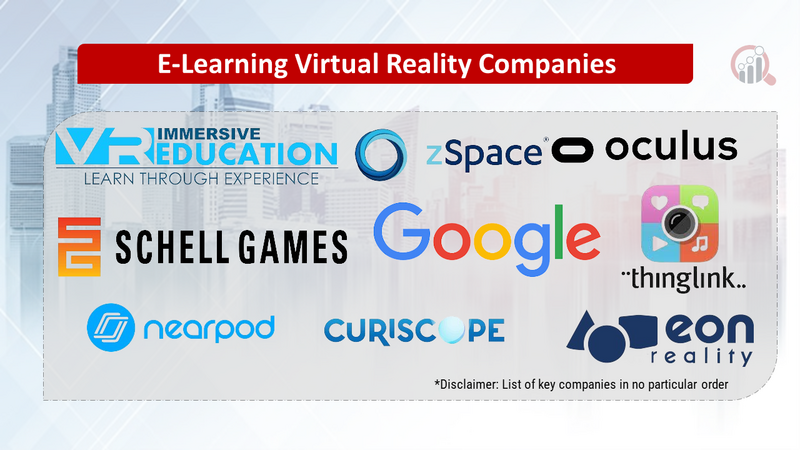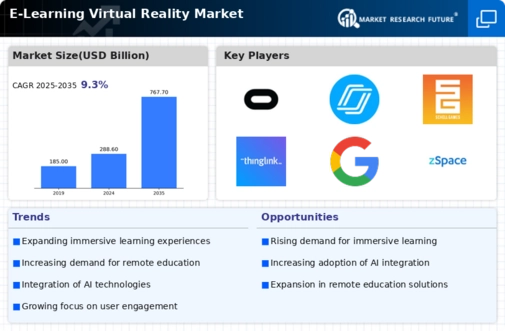Top Industry Leaders in the E-Learning Virtual Reality Market

E-Learning Virtual Reality Market: Dive into the Latest News and Updates
The educational landscape is undergoing a transformative shift, embracing immersive technologies like virtual reality (VR) to redefine learning experiences. E-learning Virtual Reality (E-VR) market is at the forefront of this revolution, offering interactive and engaging VR environments that transcend traditional textbook learning.
Some of E-Learning Virtual Reality Companies Listed Below:
- Immersive Vr Education (Ireland)
- Oculus Vr (U.S.)
- Nearpod (U.S.)
- Eon Reality Inc (U.S.)
- Schell Games (U.S.)
- Gamar (U.S.)
- Thing link (Finland)
- Google Inc. (U.S.)
- Zspace Inc. (U.S.)
- Curiscope (U.K.)
Strategies Fueling Market Growth:
-
Focus on Curriculum Integration: Developing VR experiences aligned with existing curricula and educational standards simplifies adoption and ensures learning outcomes are met. -
Collaboration with Educators and Subject Matter Experts: Working with educators and experts in specific fields guarantees realistic and effective VR simulations for diverse subjects. -
Accessibility and Cost-Effectiveness: Offering VR solutions with affordable hardware options and diverse content creation tools makes E-VR more accessible to various educational institutions and budgets. -
Emphasis on Interactivity and Engagement: VR experiences that actively engage learners through gamification, exploration, and problem-solving enhance learning outcomes and motivation.
Market Share Decoding: Key Factors to Consider:
-
Content Portfolio and Subject Focus: Companies offering extensive and diverse VR content across various subjects attract larger educational institutions and cater to broader learning needs. -
Pedagogical Soundness and Learning Outcomes: Demonstrating alignment with pedagogical principles and measurable learning outcomes builds trust and encourages wider adoption within educational settings. -
Ease of Integration and Technical Support: Seamless integration with existing learning management systems (LMS) and robust technical support for deployment and maintenance are crucial for smooth implementation. -
Hardware Compatibility and Platform Agnosticism: VR solutions compatible with diverse VR headsets and platforms expand accessibility and cater to different technology infrastructures within schools.
New and Emerging Stars: Illuminating the E-VR Path:
-
Artificial Intelligence (AI)-Powered Adaptive Learning: Startups like Immersive VR Education and Mursion are integrating AI into VR learning platforms, personalizing experiences based on individual student progress and adapting learning pathways for optimal outcomes. -
Augmented Reality (AR) Integration: Companies like Talespin and ClassVR are exploring AR overlays to complement VR experiences, blurring the lines between simulated and real environments for enhanced learning retention. -
Haptic Technology Integration: Startups like VIVE Focus 3 and Haptic Gloves are developing haptic feedback for VR learning, enabling realistic physical interactions within virtual environments to further enhance immersion and engagement.
Investment Trends: Where the E-VR Dollars Flow:
-
Cloud-Based VR Learning Platforms: Investors are backing companies developing VR platforms hosted in the cloud, enabling easy content access and management for educational institutions regardless of physical location. -
AI-Powered Adaptive Learning Tools: Investments are pouring into companies integrating AI for personalized learning within VR, aiming to optimize effectiveness and cater to diverse student needs. -
Affordable VR Hardware Solutions: Investments are supporting companies developing more cost-effective VR headsets and educational content, broadening accessibility and expanding the E-VR market reach.
Latest Company Updates:
October 26, 2023:
-
Focus on immersive and hands-on learning experiences: VR enables students to step into simulated environments and actively participate in lessons.
November 17, 2023:
-
Meta launches "Horizon Workrooms" for collaborative learning in VR: Virtual classrooms and meeting spaces foster engagement and teamwork. -
Focus on VR for soft skills development: VR simulations help students practice communication, empathy, and problem-solving in safe and controlled environments.
December 8, 2023:
-
Rise of cloud-based VR learning platforms: Offering accessibility and scalability for schools and training institutions. -
Focus on integrating VR with existing learning management systems (LMS): Streamlining content delivery and performance tracking.
January 9, 2024:
-
VR experiences address diverse learning styles: Cater to visual, auditory, and kinesthetic learners through immersive multimedia interactions. -
Focus on accessibility and inclusivity in VR learning: Making VR experiences accessible to students with disabilities through alternative controls and interfaces.
February 7, 2024:
-
AI-powered adaptive learning integrated with VR: Personalized learning paths and real-time feedback optimize knowledge retention and engagement. -
Focus on data-driven learning and performance analysis: VR data provides valuable insights to improve curriculum design and teaching methods.
February 14, 2024:
-
VR merges with augmented reality (AR) for blended learning experiences: AR overlays virtual elements onto physical environments for contextual learning.









